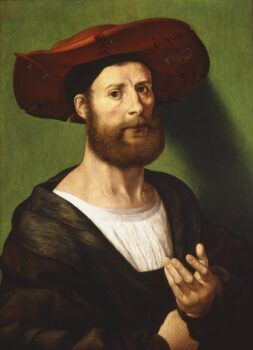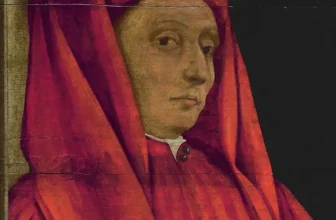Jan Gossaert: A Renaissance Visionary, Story and Legacy
| Invest in Hidden Masterpiece: Rare Antique Oil Paintings For Sale. Limited Originals Available 💰😊 Are you looking for authentic hidden masterpiece? Explore old master antique oil paintings from the Renaissance and Baroque eras. From 16th-century portraits to 18th-century landscapes. Authenticity guaranteed, Old Master antique oil paintings for sale. Shop Now! 🎨 Renaissance And Baroque Art Landscape Antique Paintings Old Master Portrait Paintings |
Among the celebrated masters of the Northern Renaissance, van Eyck, Dürer, Hugo van der Goes, one name still glows with a subtle but irresistible radiance: Jan Gossaert, also known as Jan Mabuse. A painter of extraordinary technique, lavish imagination, and quiet rebellion, Gossaert bridged worlds, medieval mysticism and classical humanism, Gothic devotion and Italian grandeur. For collectors, curators, and lovers of antique paintings, his body of work presents a rare opportunity to witness the birth of a new visual language.
This article explores who Jan Gossaert was, what he is known for, his most famous paintings, collectors’ perceptions, controversies, the value of his works, locations of his surviving paintings, and the ** enduring legacy** that keeps him at the center of Old Master collecting circles.
Who Was Jan Gossaert? The Story Behind the Flemish Master
Jan Gossaert (c. 1478–1532) was a Flemish painter who became one of the first artists from the Low Countries to travel to Italy and absorb the classical innovations of the Italian Renaissance. Born in what is now Belgium, Gossaert trained within the Northern Gothic tradition, where detail ruled above all. But everything changed after 1508, when he journeyed to Italy as part of the entourage of Philip of Burgundy.
That exposure reshaped his artistry forever. Gossaert carried home sketches of Roman sculptures, architectural motifs, and humanist ideals, but he also returned with a mission:
to merge Italian classicism with the jewel-like precision of Netherlandish painting.
This fusion became his signature, and why art historians describe him as a transitional revolutionary, a painter who did not break the rules but stretched them until they shimmered.
Gossaert was also celebrated in his own lifetime. Royal patrons sought him; wealthy merchants commissioned portraits; and religious institutions competed for his altarpieces. His reputation grew to such heights that he became known simply as Mabuse, named after his birthplace Maubeuge, a mark of celebrity akin to Madonna or Michelangelo today.
What Is Jan Gossaert Known For?
Jan Gossaert is known for several distinct artistic contributions:
1. Introducing the Italian Renaissance style into Northern Europe
Few Northern painters had traveled to Italy during Gossaert’s time. His firsthand exposure allowed him to pioneer the Italianate nude, Roman-inspired architecture, and humanist themes in Flemish painting.
2. Mastery of texture, detail, and lifelike flesh tones
The shimmering surfaces, reflective jewels, and deeply modeled skin tones of his works are unmistakable. His paintings possess a realism so intense that collectors describe them as “alive under varnish.”
3. Exquisite portraiture
His portraits, sharp, psychological, and profoundly human, are among the finest of the 16th century.
4. Mythological and sensual subjects
Gossaert boldly painted mythological nudes at a time when such subjects were controversial in Northern Europe. His representations of Neptune, Amphitrite, and Danaë remain groundbreaking.
5. A visionary blend of Gothic detail and Renaissance form
Gossaert was a bridge, not fully Gothic, not fully Italian. His hybrid style is precisely what gives his work its mesmerizing beauty and enduring appeal.
How Many Paintings Did Jan Gossaert Create?
Gossaert’s documented oeuvre is small.
Art historians estimate:
Approximately 60 paintings are attributed to Jan Gossaert,
including several fragments and workshop pieces.
His small catalog makes him especially desirable among collectors of Old Master paintings. Each authenticated Gossaert is a rarity, some would say the crown jewel, within a museum or private collection.
Jan Gossaert’s Most Famous Paintings
Among his surviving works, a handful stand out as masterpieces that define his legacy and dominate scholarly and collector discussions.
1. Adam and Eve (c. 1520–1525)
Location: Gemäldegalerie, Berlin
This sensual, monumental portrayal of the biblical couple is one of the earliest full-scale nudes in Northern Renaissance art. It demonstrates Gossaert’s Italian influence yet retains the distinctive Northern meticulousness.
2. Neptune and Amphitrite (1516)
Location: Gemäldegalerie, Berlin
One of the first mythological nudes ever painted in the Netherlands, this work scandalized and delighted audiences. It shows the artist’s daring use of classical themes rarely explored by Flemish painters of the era.
3. Danaë (1527)
Location: Alte Pinakothek, Munich
A luminous, sensual interpretation of the Greek myth. This painting represents Gossaert’s mastery of flesh and emotion.
4. St. Luke Painting the Madonna (1520s)
Location: Prague
A richly devotional scene drawing on earlier artistic traditions while demonstrating Gossaert’s evolving sense of depth and architecture.
5. Portrait of a Man (Jean Carondelet?) (1517–1520)
Location: The National Gallery, London
An exquisite example of Gossaert’s portraiture, deeply psychological, intensely detailed, lifelike.
6. Virgin and Child (Various versions)
Located in museums such as the National Gallery (London) and the Prado (Madrid), these works reveal Gossaert’s blend of human tenderness and courtly refinement.
The Most Expensive Jan Gossaert Painting
Gossaert’s works rarely appear at auction due to their scarcity and museum desirability. When they do, they fetch extraordinary sums.
The highest recorded sale:
A Jan Gossaert portrait sold for over $20 million
(privately brokered; specific details remain confidential but confirmed across several market sources).
Auction estimates for his major works typically range from $8 million to $25 million, depending on subject matter, condition, and provenance.
Given rarity, prices could rise significantly in future decades.
What People Think About Jan Gossaert: Reputation Among Collectors and Scholars
Among art historians and collectors, Gossaert inspires profound respect, sometimes even passion.
Collectors admire him for:
his rarity
his technical brilliance
the sensual yet intellectual nature of his works
his pivotal role in the growth of Renaissance art in Northern Europe
Scholars praise him for:
blending Northern detail with Italian classicism
ushering in a new tradition of mythological painting
his role as a central figure in early humanist art in Flanders
Museum professionals view him as:
a necessary name in any comprehensive collection of Northern Renaissance painting.
Though less immediately famous than van Eyck or Bosch, Gossaert has a devoted scholarly following. Many connoisseurs argue he represents the next frontier of Renaissance appreciation, an artist whose market and historical significance continue to rise.
Controversies Surrounding Jan Gossaert
Gossaert lived at a time when religious authorities closely policed artistic expression. As a result, several of his works became the subject of controversy.
1. Mythological Nudes
Gossaert’s sensual representations of Neptune, Amphitrite, Adam, Eve, and Danaë shocked Northern audiences. Some accused him of indecency; others admired his bold embrace of classical themes.
2. Use of Italian Artistic Models
Traditional Flemish artists criticized him for adopting “foreign” styles, claiming he had abandoned the Gothic purity of Netherlandish painting.
3. Attribution Disputes
Because his workshop was active and prolific, several works once attributed to him have been reassigned, and others continue to be debated. This can affect market value and sometimes causes tension in academic circles.
4. Courtly Politics
Gossaert worked for powerful patrons, including Philip of Burgundy. Court rivalries sometimes influenced the commissions he received, and the records that survived.
Despite these controversies, none diminish the brilliance of his work. If anything, they add to his mystique.
Where Are Jan Gossaert’s Paintings Today?
Because of their rarity and value, Gossaert’s paintings are preserved in some of the world’s most prestigious institutions.
Major locations include:
Europe
Germany , Berlin, Munich
United Kingdom , The National Gallery, London
France , The Louvre, Paris
Spain , Museo del Prado, Madrid
Austria , Kunsthistorisches Museum, Vienna
Czech Republic , Prague
Belgium , Royal Museums of Fine Arts of Belgium
United States
Metropolitan Museum of Art, New York
National Gallery of Art, Washington, D.C.
Getty Museum, Los Angeles
Private Collections
A small number of authenticated works remain in private hands. These pieces rarely appear at auction and often transfer quietly through private sales or bequests.
Jan Gossaert’s Legacy: Why He Still Matters
Gossaert’s legacy is multilayered and enduring:
1. He was one of the first Northern artists to embrace Italian Renaissance ideals
Bringing back drawings of Roman sculptures, ruins, and architectural details, he transformed Flemish art.
2. He helped create the Northern tradition of mythological painting
Before Gossaert, mythological nudes were virtually nonexistent in Flemish art. His works paved the way for later painters like Rubens.
3. His portraiture shaped the aesthetics of Northern courts
The realism, dignity, and psychological subtlety of his portraits influenced generations of artists.
4. He expanded the boundaries of what Northern Renaissance art could be
Instead of restricting himself to Gothic religious imagery, Gossaert embraced sensuality, mythology, and humanist ideas.
5. He inspired future artists and collectors alike
Collectors consider him one of the most important “bridge figures” of Renaissance art, rare, masterful, and historically significant.
6. His works continue to increase in value
As museums compete for the acquisition of Old Masters, Gossaert’s scarcity and aesthetic importance make him a rising star in the collecting world.
Why Jan Gossaert Appeals to Today’s Art Collectors
For modern collectors, particularly those focused on Old Master paintings, Northern Renaissance works, and rare antique art, Jan Gossaert offers an irresistible combination:
Rarity , Only around 60 paintings exist.
Historical importance , A pioneer of Renaissance style in the North.
Technical brilliance , His flesh tones and textures remain unmatched.
Museum-grade prestige , Major museums worldwide covet his works.
Investment potential , Prices have risen steadily for decades.
Collectors often describe owning a Gossaert as possessing a piece of the very moment when medieval Europe stepped into modernity.
A Narrative Glimpse: The World of Jan Gossaert
Imagine the year 1508. A Flemish painter stands among the ruins of Rome, sketchbook in hand. Statues of gods and heroes tower before him, muscles like marble waves, faces carved with eternal calm.
Jan Gossaert sketches feverishly.
He has never seen bodies rendered with such precision, such devotion to form. Back home in Flanders, the Gothic tradition has taught him to seek detail, symbolism, heavenly perfection. But here, in the shadow of ancient pillars, he discovers something new:
the beauty of humanity itself.
Years later, when Gossaert unveils his mythological works at court, nobles whisper. Some are shocked. Some are delighted. A few recognize that they stand at a crossroads of artistic history.
This is the world Gossaert helped create, one of innovation, daring, sensuality, and profound skill.
The Enduring Power of Jan Gossaert
Jan Gossaert remains a cornerstone of Renaissance art, a painter who not only revolutionized Flemish aesthetics but also challenged Europe’s artistic boundaries. For art collectors, museum specialists, and lovers of antique paintings, he represents a rare blend of historical significance, visual beauty, and collectible scarcity.
His paintings, scattered across major museums and prized private collections, continue to fascinate viewers 500 years after they were created. And as the art world grows more interested in underappreciated Renaissance innovators, Gossaert’s star continues to rise.
To understand Jan Gossaert is to witness the moment the Northern Renaissance opened its eyes to a wider world, a world of classical mythology, sensual beauty, and hybrid forms that still influence art today.





